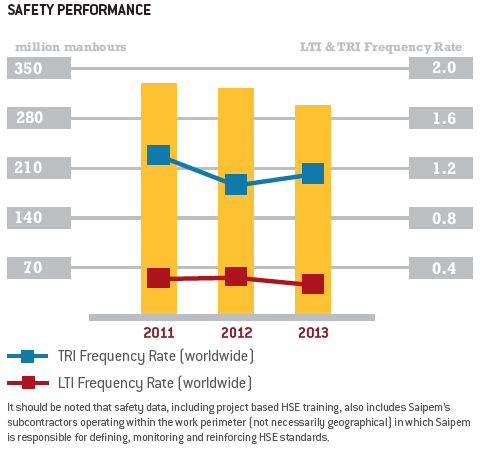HSE
Safety Performance
The TRIFR (Total Recordable Incident Frequency Rate) in 2013 reached 1.15, in line with the lower target but higher than the 2012 performance (1.06). Otherwise the results obtained for the LTIFR (Lost-Time Injury Frequency Rate) show a significant reduction of around 20% (0.26 for 2013, 0.32 for 2012). A comparison between TRIFR and LTIFR highlights a reduction of serious accidents but an increase in minor accidents. Unfortunately, during 2013 six fatal accidents occurred. These involved two subcontractor employees and four Saipem employees. As regards the Saipem employees: (i) one was crushed by a double joint pipe being moved; (ii) a second lost his life when the Perro Negro 6 rig sank following the collapse of the seabed; (iii) another fell into the sea during operations on the deck of a vessel; and (iv) another was electrocuted.
Thorough investigations were conducted for each of these tragic events and several measures were planned and implemented. These concerned corrective actions related to change management, revising corporate procedures and standards, and training and evaluation of competencies. Moreover, dedicated programmes and actions to eliminate fatalities will be developed by Saipem over the forthcoming year.

Proactive Indicators
701,329
Number of Safety Hazard Observation Cards filled in
239,475
Number of Job Safety Analyses carried out
301,820
Number of HSE inspections conducted
Awareness Campaigns
The performance results of HSE initiatives demonstrate the commitment of senior management to the health and safety of personnel and to the continuous upgrading of the Saipem HSE Management System. The most significant of those results are as follows:
-
 The Leadership in Health & Safety (LiHS) programme is the main tool developed by Saipem to promote a culture of health and safety. Pivoting on the core values of each and every one of us, not least of which is respect for human life, the validity of the LiHS programme has become universal. The first three phases of the programme were conceived on the basis of a typical cascade approach: the LiHS workshops for managers and supervisors; cascading events enabling the message to be passed from managers to their teams; “Five Star” intervention courses designed for a more operational level and therefore targeting those people in direct contact with risks. The message of the LiHS programme has reached more than 45,000 people of various levels in the Company.
The Leadership in Health & Safety (LiHS) programme is the main tool developed by Saipem to promote a culture of health and safety. Pivoting on the core values of each and every one of us, not least of which is respect for human life, the validity of the LiHS programme has become universal. The first three phases of the programme were conceived on the basis of a typical cascade approach: the LiHS workshops for managers and supervisors; cascading events enabling the message to be passed from managers to their teams; “Five Star” intervention courses designed for a more operational level and therefore targeting those people in direct contact with risks. The message of the LiHS programme has reached more than 45,000 people of various levels in the Company. -
In 2013 Saipem SA launched a “Keep Your Hands Safe” campaign to promote awareness and practical knowledge of safety procedures and the correct use of tools. While launched in Saipem SA Head Office, the campaign has been designed with a view to implementation in fabrication yards, vessels and offices over a two-year period.
-
Adopting a healthy lifestyle is the result of an individual choice. Saipem has therefore chosen to invest energy and resources in a new programme called “Choose Life”, dedicated to developing a health culture to go hand in hand with that of safety. The ‘“Choose Life” campaign was launched in San Donato Milanese in May 2013. In a dedicated meeting, top management laid the foundation for the establishment of a new “Health Vision”, in which core values such as the welfare of the people, disease prevention, and respect and care for oneself and others are affirmed.
-
Prevention of cardiovascular disease is a lifelong battle. This has prompted Saipem to mount campaigns and implement measures to reduce its incidence and alleviate its effects on employees. Saipem’s Cardiovascular Disease Prevention Programme (CVDPP) aims to identify, assess, monitor and control modifiable cardiovascular risk factors such as blood fat levels, blood sugar, blood pressure, physical inactivity, smoking, and so forth.
-
Saipem is committed to protecting the health of its workforce and to improving that of its host communities. In 2013, 47 sites located in endemic areas were all involved in the Saipem Malaria Control Programme. 5,312 people attended courses on malaria risk. These discussed important issues such as prevention and prophylactic measures. In 2013, the overall Malaria Case Rate (MCR - i.e. the incidence of stewardable malaria cases per 200,000 exposure-hours) was 0.09.
413
LiHS EVENTS PERFORMED
23
CHOOSE LIFE EVENTS ORGANISED